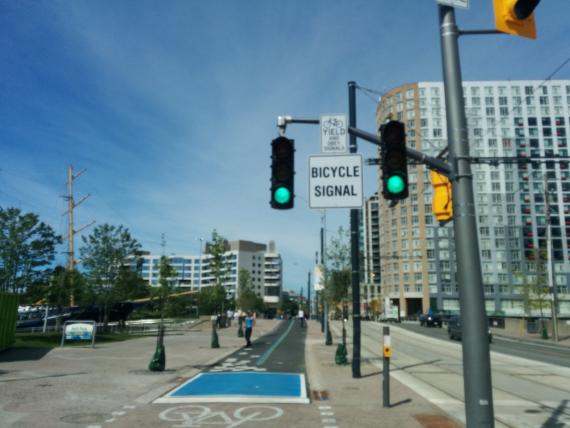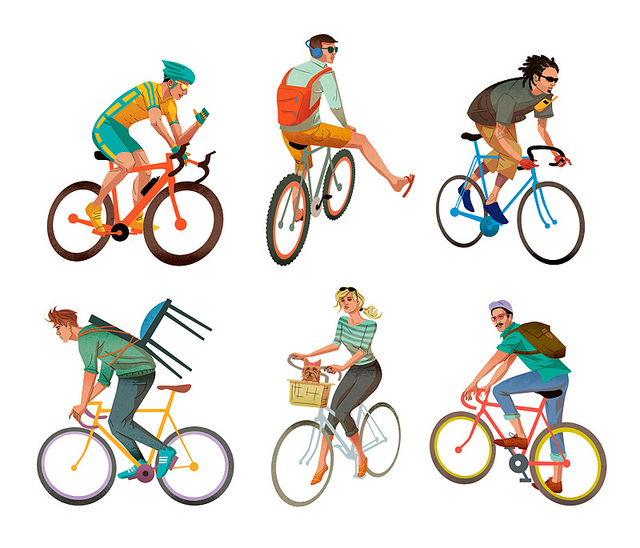Whether the cycling aimed path (the other is the boardwalk, pedestrian only) to the east and west of the Humber Bay Bridge is a "cycle track" or not is a good question. The City has created a real muddle on this, but for Queen's Quay, the point is clear that it is:
Cycle Track FAQ
What is a Cycle Track?
Cycle Tracks are separate lanes for bicycles that are adjacent to the roadway, but separated from vehicular traffic. The first such lane has been installed on Sherbourne Street between Bloor and King Street.
Why is Toronto building cycle tracks?
Cycle tracks help to make the area for cycling that is more separate from motor vehicle traffic than a painted bicycle lane. This fosters and environment which is safer for cycling, and which encourage people who wish to ride their bicycles, but do not feel safe in regular traffic lanes or in painted bicycle lanes.
Will the Cycle Track be cleared of snow, and other debris such as glass?
The level of service for ploughing and sweeping will be similar to that of the rest of the roadway.
Should pedestrians walk or stand in the cycle track?
No. Pedestrians should only walk on the sidewalk, not on the cycle track. The cycle track is for cyclists only.
Should cyclists ride on the sidewalk?
No. Cyclists should not ride on city sidewalks. Sidewalks are for pedestrians.
Are cycle tracks the same as multi-use park paths?
No. Multi-Use park paths are not part of a street. Cycle Tracks are part of the street. Multi-use paths are shared use facilities used by both pedestrians and cyclists in green spaces such as City parks. Cycle tracks in Toronto are built on roadways, next to sidewalks. Cycle Tracks are for cycling only and sidewalks are for pedestrians only.
Should people waiting for Transit vehicles stand in the cycle track?
No. Pedestrians should wait on the sidewalk, not in the cycle track, when waiting for a transit vehicle.
When a transit vehicle has stopped and opened its doors to pick up passengers, patrons should walk across the cycle track to board the transit vehicle.
When the doors of the transit vehicle are opened, cyclists must yield to these patrons, following the same protocol as when waiting for transit patrons to cross a curb lane to board a streetcar.
Should TTC Buses Stop in the Cycle Track, or regular Traffic Lane?
TTC Buses should stop in the regular traffic lane. Motor vehicles and cyclists must wait for TTC patrons to board the TTC vehicle before proceeding. When the doors of the TTC vehicle are open, cyclists must yield to these TTC patrons, following the same protocol as when waiting for TTC patrons to cross a curb lane to board a streetcar.
Why does the cycle track surface slope up and down TTC stops?
At TTC stops, the cycle track has been build to provide level boarding from the sidewalk, to the TTC vehicle.
Can emergency vehicles such as EMS or Fire Trucks stop, park, or drive in the Cycle Track?
From time to time, an emergency vehicle may cross or occupy a cycle track when responding to an emergency situation.
Should taxi drivers stop, park, or drive in the Cycle Track?Taxi drivers with regular patrons should not stop, park, or drive in the cycle track. Private vehicles under contract to WheelTrans may pick up or drop off persons with a disability by pulling into the cycle track.
Should private cars, trucks or SUVs stop, park or drive in the Cycle Track?
Private vehicles should not stop, park, or drive in the Cycle Track.
Should delivery or courier vehicles stop, park or drive in the Cycle Track?
Private delivery vehicles should not stop, park, or drive in the Cycle Track. Private delivery vehicles must find a legal parking spot near the cycling track which they can use to make their delivery.
Can E-Bikes drive in the Cycle Track?
In Toronto, only E-bikes which meet the City of Toronto definition of a "Pedalec" may be used in a Cycle Track. Learn more about the difference between a "Pedelec" and a "E-scooter" on the
"Power Assisted Bicycles" webpage.
Who has the right of way at intersections? Bicycles riding across the intersection in the cycle track or right turning vehicles in the regular traffic lane?
Signs have been erected at intersections giving the cyclists in the cycle track the right of way. Motorists turning right at an intersection must carefully shoulder check for cyclists using the cycle track, before merging across the cycle track in order to make their right hand turn.
I want to ride more quickly than the cyclist in front of me, how do I pass slower cyclists now that a curb separates the cycle track from the other traffic lanes?
It is important to be respectful of all cyclists using the cycle track.If you are in a section of the cycle track where passing other cyclists is not possible, remember that there are many breaks in the cycle track's curb including intersections, driveways and other junctions where there is more space to pass.
When I'm passing a slower cyclist, how much space should I leave between me and the person I'm passing?
Please pass other cyclists only when the space between the widest point on your bike, and the widest point on the other person's bike (usually handle bar to handle bar) has a minimum of 10 inches to 1 foot clearance. Always pass on the left. It can be dangerous to pass a slower cyclist when you are travelling in close proximity.
How do I position myself in the cycle track, if the cycle track is busy and I know I will be passed by faster cyclists?
Slower cyclists are encouraged to comfortably position themselves to the RIGHT side of the cycle track, so that they may more easily be passed by faster cyclists on the LEFT.
Is there a polite way to let someone know that you will be passing them as you approach?
The standard practice for both mountain bikers and road cyclists to say "
on your left", "
rider left" or "
passing left" as you approach the cyclist you will be passing. You don't need to shout, just politely alert them to your presence in a regular speaking voice. You can also use your bell to help make other riders you are approaching them from behind.
[continues...]
http://www1.toronto.ca/wps/portal/contentonly?vgnextoid=f97edd5e4cf12410VgnVCM10000071d60f89RCRD#a04










